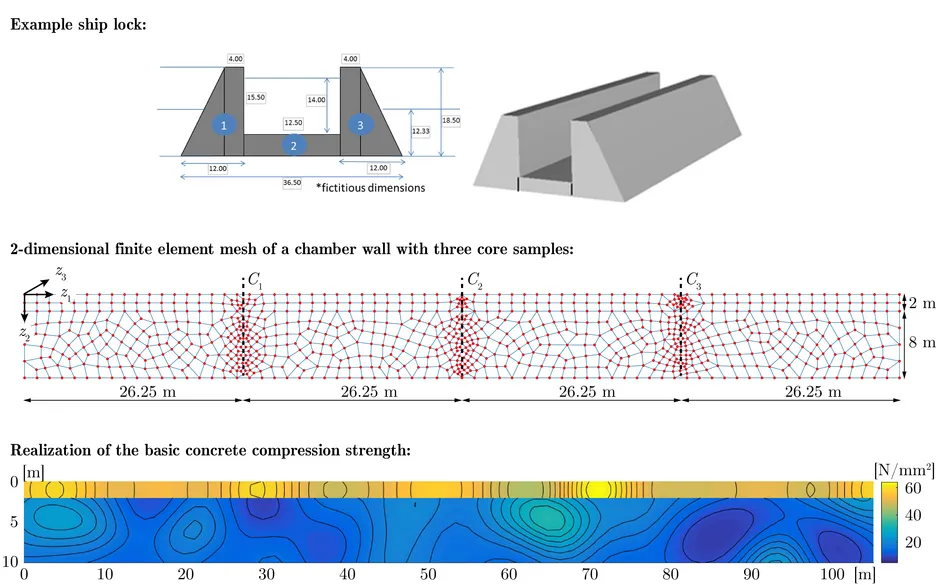Reliability of existing hydraulic structures
The assessment of engineering structures from a probabilistic point of view has gained importance in the field of civil engineering, especially for large structures or infrastructure systems. Potentially large reduction of costs together with an increased safety level justify the need for more extensive modeling and reliability analyses. At the moment, reliability analyses with probabilistic modeling are poorly standardized, which on the one hand increases the effort for the application and on the other hand leads to difficulties in the interpretation of the results. Although the current version of European design standards includes a concept for the design or recalculation of structures with probabilistic modeling, this concept is mostly used for research and future developments. In Germany, the Bundesanstalt für Wasserbau (BAW) is in charge of the hydraulic structures of the waterway system. That is, more than 1000 ship locks, weirs, culverts and others and more than 1600 bridges are run and maintained by BAW. BAW plans to incorporate probabilistic analyses in the assessment of existing and the design of new hydraulic structures. For this purpose, a user-oriented guideline for the standardized application of reliability analyses is to be developed. This research project aims at developing efficient methods for supporting BAW in conducting economic and meaningful probabilistic analyses for hydraulic structures which are distributed all over the German waterway system. This project focuses on the inclusion of spatially variable parameters in reliability analyses of unreinforced and reinforced concrete structures and the adaption of structural reliability methods for the specific use on hydraulic structures. To this end, advanced problem settings are to be investigated, which are of special relevance for hydraulic structures.

Researchers
Funding
Publications
- Sebastian Geyer, Iason Papaioannou, Daniel Straub (2023). Spatial modeling of concrete strength based on data. Structural Safety, 103,
102345 - Sebastian Geyer, Iason Papaioannou, Daniel Straub (2023). Spatial modeling of concrete strength based on data. Structural Safety, 103,
102345 - Sebastian Geyer, Iason Papaioannou, Lori Graham-Brady, Daniel Straub (2022). The spatial averaging method for non-homogeneous random fields with application to reliability analysis. Engineering Structures, 253, 113761
- Sebastian Geyer, Iason Papaioannou, Daniel Straub (2021). Bayesian analysis of hierarchical random fields for material modeling. Probabilistic Engineering Mechanics, 66, 103167
- Sebastian Geyer, Iason Papaioannou, Daniel Straub (2020). Characteristic values of spatially varying material properties in existing structures. Proceedings of the Seventh International Symposium on Life-Cycle Civil Engineering (IALCCE). Shanghai, China
- Sebastian Geyer, Iason Papaioannou, Claus Kunz, Daniel Straub (2020). Reliability assessment of large hydraulic structures with spatially distributed measurements. Structure and Infrastructure Engineering, 16(4), 599-612
- Iason Papaioannou, Sebastian Geyer, Daniel Straub (2019). Bayesian updating of foundation reliability with spatially variable measurements: a spatial averaging approach. Proceedings of the 7th International Symposium on Geotechnical Safety and Risk (ISGSR). Taipei, Taiwan
- Sebastian Geyer, Iason Papaioannou, Claus Kunz, Daniel Straub (2019). Bayesian reliability assessment with spatially variable measurements: The spatial averaging approach. Proceedings of the 13th International Conference on Applications of Statistics and Probability in Civil Engineering (ICASP13). Seoul, South Korea
- Sebastian Geyer, Iason Papaioannou, Daniel Straub, Claus Kunz (2018). Reliability assessment of large hydraulic structures with spatially distributed measurements. Proceedings of the Sixth International Symposium on Life-Cycle Civil Engineering (IALCCE). Ghent, Belgium
- Arslan Tahir, Claus Kunz, Sebastian Geyer, Daniel Straub (2018). Investigation into structural reliability of reinforced concrete hydraulic structures using different probabilistic methods. Proceedings of the International Federation for Structural Concrete 5th International fib Congress, Melbourne, Australia
